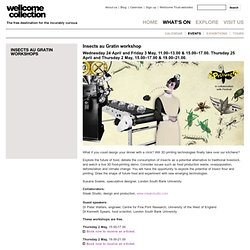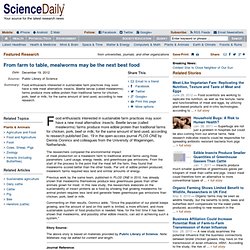

Insects au Gratin workshops. What if you could design your dinner with a click?

Will 3D printing technologies finally take over our kitchens? Explore the future of food, debate the consumption of insects as a potential alternative to traditional livestock, and watch a live 3D food-printing demo. Consider issues such as food production waste, overpopulation, deforestation and climate change. You will have the opportunity to explore the potential of insect flour and printing. Draw the shape of future food and experiment with new emerging technologies. Susana Soares, speculative designer, London South Bank University Collaborators:Steak Studio, design and production, www.steakstudio.com Guest speakers:Dr Peter Walters, engineer, Centre for Fine Print Research, University of the West of England Dr Kenneth Spears, food scientist, London South Bank University These workshops are free. Thursday 2 May, 15.00-17.00 Book now to receive an e-ticket.
Thursday 2 May, 19.00-21.00 Book now to receive an e-ticket. Environmental Impact of the Production of Mealworms as a Protein Source for Humans – A Life Cycle Assessment. The demand for animal protein is expected to rise by 70–80% between 2012 and 2050, while the current animal production sector already causes major environmental degradation.

Edible insects are suggested as a more sustainable source of animal protein. However, few experimental data regarding environmental impact of insect production are available. Therefore, a lifecycle assessment for mealworm production was conducted, in which greenhouse gas production, energy use and land use were quantified and compared to conventional sources of animal protein.
Production of one kg of edible protein from milk, chicken, pork or beef result in higher greenhouse gas emissions, require similar amounts of energy and require much more land. This study demonstrates that mealworms should be considered a more sustainable source of edible protein. Figures Citation: Oonincx DGAB, de Boer IJM (2012) Environmental Impact of the Production of Mealworms as a Protein Source for Humans – A Life Cycle Assessment. From farm to table, mealworms may be the next best food. Food enthusiasts interested in sustainable farm practices may soon have a new meat alternative: insects.

Beetle larvae (called mealworms) farms produce more edible protein than traditional farms for chicken, pork, beef or milk, for the same amount of land used, according to research published Dec. 19 in the open-access journal PLOS ONE by Dennis Oonincx and colleagues from the University of Wageningen, Netherlands. The researchers compared the environmental impact of meat production on a mealworm farm to traditional animal farms using three parameters: Land usage, energy needs, and greenhouse gas emissions. From the start of the process to the point that the meat left the farm, they found that mealworms scored better than the other foods. Per unit of edible protein produced, mealworm farms required less land and similar amounts of energy.
UN urges people to eat insects to fight world hunger. U.N. Urges Eating Insects; 8 Popular Bugs to Try. Ants are sweet, nutty little insects, aren't they?

I'm not talking about their personalities, but how they taste. Stinkbugs have an apple flavor, and red agave worms are spicy. A bite of tree worm apparently brings pork rinds to mind. This information will come in handy for those of us following the latest recommendation from the United Nations: Consume more insects. A report released Monday by the U.N. In fact, some two billion people eat a wide variety of insects regularly, both cooked and raw; only in Western countries does the practice retain an "ick" factor among the masses.
Why eat something that we usually swat away or battle with insecticides? One example: mealworms, the larval form of a particular species of darkling beetle that lives in temperate regions worldwide. And raising and harvesting insects requires much less land than raising cows, pigs, and sheep. 1. The most commonly eaten beetles are the long-horned, june, dung, and rhinoceros varieties.